

Algorithms. Gigaspaces XAP. HANA. In-Mem Analytics. MS SQL Server. Open Source. Others. TimesTen. TurboData. IoDrive. Fusion's ioDrive dramatically improves application response times with a persistent, high-performance, high-capacity ioMemory tier.

It enables data decentralized architectures that move terabytes of process-critical data into servers. This minimizes application latency to deliver groundbreaking improvements to computing performance, while greatly reducing hardware infrastructure, maintenance, floor space, and energy costs. Minimizes latency and eliminates I/O bottlenecks by integrating with host servers as a memory tier extension.
Easily outperforms dozens of SSDs on a single server Accelerates applications, improves response times, and boosts efficiency Delivers the performance of thousands of disk drives in a single server From 160GB - 640GB of enterprise solid-state flash Easy installation and comprehensive data center management supported by the ioSphere™ Management Solution Approved for enterprise use by Fusion-io partners, including HP, IBM, Dell, and Supermicro.
Recap of IBM Twitterchat: How In-Memory Technology is Transforming Big Data. Nothing screams “speed of business” quite like in-memory technology.

On Wednesday, March 27, I participated in an IBM Twitter chat with analysts, influencers, thought leaders, fellow IBM-ers and others on this very topic. The event took take place from 12-1pm EDT and used hashtag #bigdatamgmt. (You can catch us bi-weekly - starting again April 17 - on Twitter at this time using that hashtag.) Here are highlights from the discussion. Note that I’m using edited versions of the questions that the moderator (the all-knowing @IBMBigData) asked. Natalino Busa: Beyond hadoop: in-memory map reduce with the Berkeley Data Analytics Stack (BDAS) One of the strongest points of the original hadoop is an immutable distributed file system.
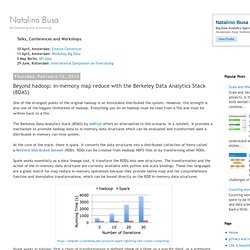
However, this strength is also one of the biggest limitations of hadoop. Everything you do on hadoop must be read from a file and must be written back to a file. The Berkeley Data Analytics Stack (BDAS) by AMPlab offers an alternatives to this scenario. In a nutshell, it provides a mechanism to promote hadoop data to in-memory data structures which can be evaluated and transformed used a distributed in-memory run-time system. At the core of the stack, there is spark. Spark works essentially as a data lineage tool, it transform the RDD's into new structures. Spark works as follows: first a chain of transformations is defined (think of a filter on a specific field, or a arithmetic operation on the elements of the dataset), then the results are extracted.
Shark is an extension on the base spark stack, and it provides an in-memory distributed sql. Accelerating Enterprise Insights: 2013 IOUG In-Memory Strategies Survey. Overview of Database Cache, High performance main memory database cache. In-memory database. An in-memory database (IMDB; also main memory database system or MMDB or memory resident database) is a database management system that primarily relies on main memory for computer data storage. It is contrasted with database management systems that employ a disk storage mechanism. Main memory databases are faster than disk-optimized databases since the internal optimization algorithms are simpler and execute fewer CPU instructions.
Accessing data in memory eliminates seek time when querying the data, which provides faster and more predictable performance than disk.[1][2] In applications where response time is critical, such as telecommunications network equipment and mobile advertising networks, main memory databases are often used.[3] IMDBs have gained a lot of traction, especially in the data analytics space, starting mid-2000s mainly due to cheaper RAM.[4][5] ACID support[edit] In-Memory Databases. Small.
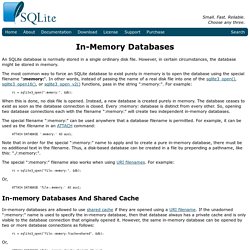
Fast. Reliable.Choose any three. An SQLite database is normally stored in a single ordinary disk file. However, in certain circumstances, the database might be stored in memory. Enterprise Platform and Integration Concepts - IpadDemos. In-Memory Database Systems Questions and Answers. In-Memory Database for Web-Scale Applications & Real-Time Big Data. InsideFlash.com - Your connection to all Flash Technologies at EMC. Data management for business-critical web applications. Big Analytics & Discovery Blog » Blog Archive » In-Memory Data Processing.
Recently, a journalist called to ask about in-memory data processing, a very interesting subject.
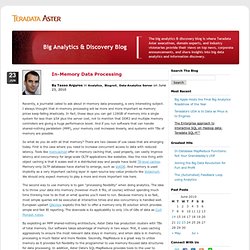
I always thought that in-memory processing will be more and more important as memory prices keep falling drastically. In fact, these days you can get 128GB of memory into a single system for less than $5K plus the server cost, not to mention that DDR3 and multiple memory controllers are giving a huge performance boost. And if you run software that can handle shared-nothing parallelism (MPP), your memory cost increases linearly, and systems with TBs of memory are possible. So what do you do with all that memory? There are two classes of use cases that are emerging today. The second way to use memory is to gain “processing flexibility” when doing analytics. Business Discovery Blog: A Conversation with Ql... I sat down and talked with Håkan Wolgé, the main architect behind QlikView, while I was in Sweden a few weeks ago.

I had two main questions for him about his take on QlikView and the associative experience. Erica Driver: At QlikTech we use the word "associative" to describe one of QlikView's differentiators. What does this word mean to you? Håkan Wolgé: QlikView is all about the user experience. Not just the user interface . . . the user experience. Embedded databases for real-time, embedded systems – eXtremeDB in-memory database, Perst Java and C# database, SQL, XML. MemSQL. In-Memory Database Technology for Embedded and Real-Time Systems. The eXtremeDB Embedded Database. The Importance of In-memory Databases. It has been predicted that in-memory computing will be one of the Top 10 technologies of 2012.

In-memory databases (IMDBs) are a critical part of this paradigm. Through this introductory article, let’s get acquainted with the basics of IMDBs. We will look at what they are, why they are developed, and the key differences between IMDB and traditional disk DBs. In-Memory Databases Driving Big Data Efficiency: 10 Reasons Why. Dealing With the Half Life of Data Value Businesses need to move fast.
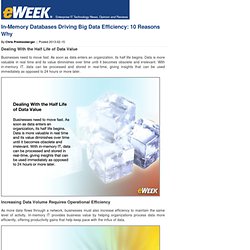
As soon as data enters an organization, its half life begins. Data is more valuable in real time and its value diminishes over time until it becomes obsolete and irrelevant. The Rise of In-Memory Databases. For more years than anyone can remember, the relationship between databases and disk drives has been one of mutual dependency.
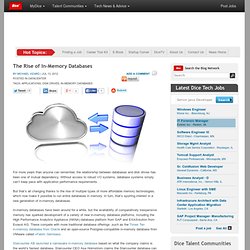
Without access to robust I/O systems, database systems simply can’t keep pace with application performance requirements. Www.nec.com/en/global/techrep/journal/g12/n02/pdf/120206.pdf.